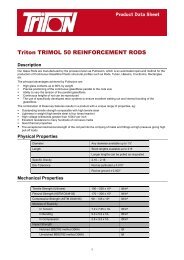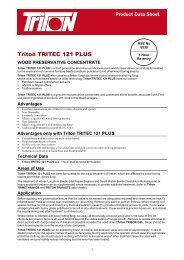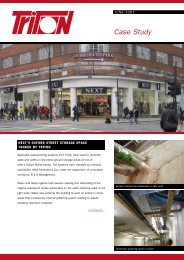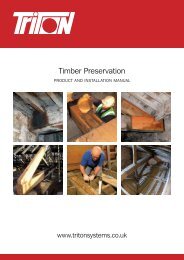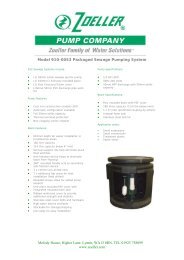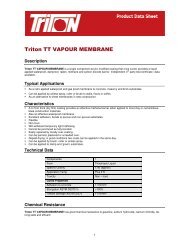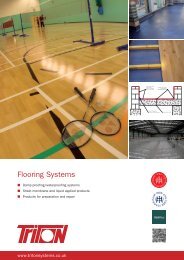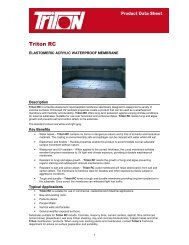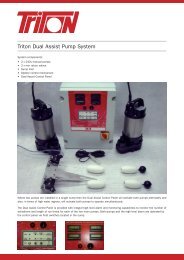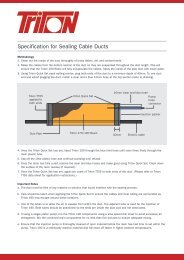Triton Chemical Manufacturing Co. Ltd. - Triton Chemicals
Triton Chemical Manufacturing Co. Ltd. - Triton Chemicals
Triton Chemical Manufacturing Co. Ltd. - Triton Chemicals
- No tags were found...
You also want an ePaper? Increase the reach of your titles
YUMPU automatically turns print PDFs into web optimized ePapers that Google loves.
Health & Safety Handling Guide<strong>Triton</strong> TT Super / Super WhiteIf care is taken not to raise dust and the exposure levels fornuisance dusts are not exceeded, the levels for respirablesilica should be very low.Applying Occupational Exposure Standards EH40/95 Sections40 and 4.1. Also see Dust: General Principles of ProtectionHSE Guidance Note EH 44 Rev 1991.• Occupational Exposure Standard Limits - 8 hour TWA,reference period from Guidance Note EH40/95, Table 2.Amorphous Silica:Total inhalable dust: 6mg/m 3Respirable dust: 3mg/m 3Portland Cement:Total inhalable dust: 10mg/m 3Respirable dust: 5mg/m 3Respiratory Protection:Suitable respiratory protection should be worn to ensurethat personal OES is not exceeded. If care is taken not toraise dust during handling the use of respirators is notnormally necessary.Hand Protection:Wear suitable gloves.Eye Protection:Suitable goggles or face protection should be wornwherever there is a risk of product powder or product /water mixture entering the eye.Skin Protection:Wear overalls and closed footwear.( 8 ) PHYSICAL AND CHEMICAL PROPERTIESPhysical State: ParticulateParticle Size: 5 - 6000 pmpH: pH of wet cement 12 - 14( 9 ) STABILITY AND REACTIVITYStable under normal room temperature storage conditions.Bags will set solid if continually soaked with water.( 10 ) TOXICOLOGICAL INFORMATIONEye <strong>Co</strong>ntact:Cement constituent is severe eye irritant. Mild exposurescan cause soreness. Gross exposures or untreated mildexposurescan lead to chemical burning and ulceration ofthe eye.Skin <strong>Co</strong>ntact:The powder or product/water mixture may cause irritation,contact dermatitis or allergic dermatitis and/or burns.Inhalation:Inhalation of the powder may cause inflammation ofmucous membranes.Ingestion:The swallowing of small amounts of product or product /water mixtures is unlikely to cause any significantreaction. Larger doses may result in irritation to the gastrointestinal tract.( 11 ) ECOLOGICAL INFORMATIONAquatic Toxicity Rating:LC50 aquatic toxicity rating has not been determined.The addition of any cement based product to water may,however, cause the pH to rise and therefore may be toxicto aquatic life in some circumstances. No other specificinformation available.( 12 ) DISPOSALDispose of empty bags or surplus product to a placeauthorised to accept builders' waste. Keep out of reach ofchildren. Small numbers of bags can be disposed of asnormal household wastes.( 13 ) TRANSPORT INFORMATIONClassification for Transport not required.( 14 ) REGULATORY INFORMATIONSymbols: Xi Irritant.Risk PhasesR36/37/38: Irritating to eyes, respiratory systems andskin.Safety PhasesS22: Do not breathe dust.S28: After contact with skin, wash immediatelywith plenty of soap and water.S26: In case of contact with eyes, rinseimmediately with plenty of water and seekmedical attention.S24/25: Avoid contact with skin and eyes.S37/39: Wear suitable gloves and eye/face protection.Keep out of reach of children.( 15 ) OTHER INFORMATIONDate: 22 ND June 2007This revision supersedes all previous<strong>Triton</strong> <strong>Chemical</strong> <strong>Manufacturing</strong> <strong>Co</strong> <strong>Ltd</strong><strong>Triton</strong> House, Lyndean Industrial Estate, Abbeywood, London,SE2 9SG.Tel: 020 8310 3929 Fax: 020 8310 3929www.triton-chemicals.com



